can you use anhydrous sodium sulfate to dry ethanol
What Does Drying Ethanol Mean?
Drying ethanol is more than just removing water from it. It’s about creating a highly purified form of ethanol that serves specific industrial and lab needs.
Anhydrous Ethanol vs. Hydrated Ethanol
At their core, anhydrous ethanol and hydrated ethanol differ in water content.
- Hydrated Ethanol: Contains water, often around 5% or more. It’s also referred to as “wet ethanol.” Typical applications include cosmetics, cleaning agents, and lower-grade fuel options. Simple distillation can produce this type, but further dehydration is omitted.
- Anhydrous Ethanol: Nearly water-free, with a water content of less than 0.5%. It’s also called “absolute ethanol.” This type is perfect for uses requiring precision, such as in pharmaceuticals, biofuels, and scientific research. Learn more from Field to Pump’s analysis.
The key distinction lies in their purpose. Where durability and burning efficiency are critical (think biofuels), anhydrous ethanol wins. However, hydrated ethanol often suffices for less demanding tasks.
Why Remove Water from Ethanol?
Drying ethanol ensures it performs optimally in various roles. But why is this crucial? Here’s what happens when water is removed:
- Improved Combustion Efficiency
Water in ethanol reduces its energy output. For engines and fuel systems, anhydrous ethanol offers cleaner burning and more power. - Lab Precision
Chemistry doesn’t tolerate guesswork. Anhydrous ethanol provides the consistency labs require for accurate results and precise reactions. - Pharmaceutical Purity Requirements
Medications demand tightly controlled ingredients. Removing water ensures ethanol purity for medical-grade applications.
Dry ethanol also prevents absorption of atmospheric moisture, which can interfere with sensitive processes or storage conditions. Check out this source for a deeper dive into ethanol’s role in gasoline.
Ultimately, understanding the purpose of drying ethanol boils down to recognizing when only pure ethanol will achieve the desired outcome. It makes a difference in everything from fuel performance to drug creation.
Anhydrous Sodium Sulfate: A Common Drying Agent
When working with ethanol, water often becomes an uninvited guest. Removing this water is vital in ensuring ethanol’s usability for specific applications. One popular solution to this problem is anhydrous sodium sulfate, a widely-used drying agent in various industries.
What Makes Sodium Sulfate Effective?
Anhydrous sodium sulfate (Na₂SO₄) is a white, crystalline substance that lacks moisture. Its primary function as a drying agent stems from its ability to absorb and trap water molecules. When added to a wet solution like ethanol, it takes advantage of the water molecules’ polarity. Sodium sulfate’s crystal structure has room to incorporate water, binding it within its framework.
Sodium sulfate is especially effective when the ethanol solution isn’t overly wet. If you’re working with ethanol containing small to moderate amounts of water, this drying agent can make a significant dent in the moisture content. However, its high capacity for water absorption has practical limits, making it less effective for solutions with very high water content. Learn more about sodium sulfate’s properties here.
How Sodium Sulfate Compares to Other Drying Agents
Drying ethanol isn’t a one-size-fits-all process. Different drying agents have unique strengths. Here’s how anhydrous sodium sulfate stacks up against other common choices:
- Magnesium sulfate (MgSO₄):
- Effectiveness: Absorbs water quickly and efficiently, often outperforming sodium sulfate.
- Drawbacks: Messier to handle; tends to clump, making it harder to work with under certain conditions. Check out this detailed comparison.
- Potassium carbonate (K₂CO₃):
- Effectiveness: Works better for slightly wet solvents but may not be suitable for ethanol with a high water concentration.
- Bonus: Favored for its dual role as a drying agent and a stabilizer for certain chemicals.
- Molecular sieves:
- Effectiveness: Extremely efficient, capable of reducing water to trace levels.
- Drawbacks: Often more expensive and take longer to reach equilibrium, requiring overnight drying in some cases. Explore molecular sieves’ properties here.
While sodium sulfate may not outmatch magnesium sulfate or molecular sieves for absolute water removal, it remains a convenient, cost-effective choice when working with moderately hydrated ethanol.
Steps to Use Sodium Sulfate for Drying Ethanol
Drying ethanol using anhydrous sodium sulfate is straightforward. Here’s a step-by-step guide to get it done effectively:
- Prepare Sodium Sulfate:
- Ensure the sodium sulfate is completely anhydrous. If it’s clumpy, it may have already absorbed water from the air.
- Add to Ethanol:
- Measure the ethanol volume and sprinkle 10–15 g of sodium sulfate per 100 mL of ethanol into your container.
- Swirl or Stir:
- Gently swirl the mixture or stir for a few minutes to enable the sodium sulfate to interact with the water molecules in the ethanol.
- Wait:
- Allow the mixture to sit for about 20–30 minutes. This ensures maximum absorption.
- Filter:
- Separate the sodium sulfate from the ethanol by filtration or decantation. The remaining ethanol should now contain significantly less water.
- Repeat if Necessary:
- If the ethanol is still not dry enough, repeat the process with a fresh batch of sodium sulfate.
Using sodium sulfate is hassle-free and effective when the water content is within reasonable levels. However, if you’re working with extremely high water content or require ultra-dry ethanol, you may need to explore alternatives like molecular sieves. Read more about using drying agents here.
Success in drying ethanol often lies in understanding the strengths and limits of your chosen drying agent. Sodium sulfate, while not perfect for every scenario, remains a valuable tool in the chemical toolbox.








